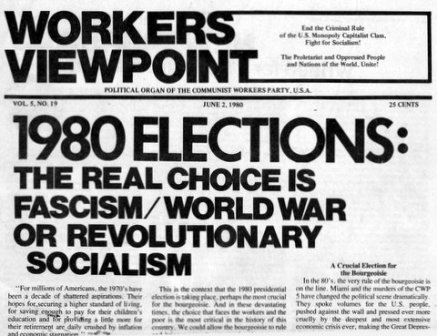
First Published: Workers Viewpoint, Vol. 5, No. 19, June 2, 1980.
Transcription, Editing and Markup: Paul Saba
Copyright: This work is in the Public Domain under the Creative Commons Common Deed. You can freely copy, distribute and display this work; as well as make derivative and commercial works. Please credit the Encyclopedia of Anti-Revisionism On-Line as your source, include the url to this work, and note any of the transcribers, editors & proofreaders above.
Jerry Tung. General Secretary of the Communist Workers Party, recently pointed out the implications of the Miami revolt for the 80’s, “The Miami revolt speaks for the whole U.S. people, the Levittowns, Love Canals; the number of Afro-American revolts in recent weeks, are indicators, foreshadowing the revolutionary situation to come. The massive food riots, widespread armed clashes of striking workers and the state, the revolt of the multinational working class, the revolt of the multinational jobless, the multinational poor, and the siding of the petty bourgeoisie .... The spontaneous revolutionary situation, the ripening of the spontaneous subjective factor may come soon – whether we are ready or not – the situation will be entirely different, with a spontaneous revolutionary situation like in South Korea now. The bourgeoisie will not be sufficiently centralized to concentrate forces to suppress them but the masses will not have the leadership to seize power if we are not prepared.”
The entire working class has been tremendously inspired and aroused by the raw class hatred of Miami that was directly aimed at the state, the common oppressor of the U.S. people. The full force of the Afro-American masses’ anger was directed at the two clearest symbols of the state – the police headquarters and the justice building. After the state, the masses confiscated the property of the biggest capitalists with more consciousness than any of the rebellions of the 60’s. The biggest stores were stripped clean and set afire. The masses spraypainted “payback” on what was left to make it clear that this was revenge for years of national oppression under monopoly capitalism.
Because the Miami rebellion was aimed at the state, both Afro-Americans and white masses alike instinctively took a stand in support of the rebellion. One white couple, Paul and Ruth Jones whose home was burned during the rebellion made this clear. “What you have to understand about this whole McDuffie thing is that it isn’t black against white, it’s the poor against the cops and the rich.” This is the view of the majority of the workers as more than 70% of the callers on talk shows during the rebellion clearly supported the rebellion.
There is no way that this could have happened during the 60’s. If you think that Miami is a “throwback to the 60’s” like the Amsterdam News, a New York black newspaper, then you don’t understand what the 80’s are all about. During the 60’s the working class was asleep and the American Dream still had credibility. U.S. imperialism was still in a period of temporary stabilization, and the U.S. was the hegemonic power in the world and could export the crisis abroad to Western Europe, Japan and third world countries.
In the 80’s all the chickens for the U.S. imperialists have come home to roost from Iran to South Korea, and the working class has to carry the full weight of the deepest economic crisis in history. The illusions of making it have evaporated right before the eyes of the U.S. people. And for the Afro-American masses the American Dream never existed in the first place. The meager crumbs of the 60’s which gave a ray of hope to blacks has been ground to dust. The economic crisis of the 80’s has intensified national oppression all along the line. Because the weight of national oppression is so heavy, many times in history, Afro-Americans have been the first to stand up and fight, acting like shock troops that wake up the whole country. But the difference between now and the 60’s is that the punishment the working class has been forced to endure under the weight of the economic crisis of the 80’s is pushing the U.S. people into increasingly sharp struggle with the state.
In the “model suburb” of Levittown. Pa., white workers and youth took over the streets of the city, and fought the police and the National Guard for three days over the high price of gasoline. Angry residents of Love Canal. N.Y., whose lives have been permanently broken along with their trust in the U.S. government, took two government officials hostage to demand money to get away from Love Canal. Sell-out union leaders are being dumped left and right, and at the same time, strikes like the one in Washington, Indiana, where armed battles with scabs occurred and the mayor’s house got firebombed, are increasingly becoming the rule. This is the backdrop of the Miami uprising.
Because Miami speaks for the whole country, no rebellion has shaken the capitalist class like the Miami uprising. Carter is so scared that he would rather take his chances with volcanic Mount St. Helens, before he would confront the people of Miami. Panicked over what the Miami revolt could lead to, the capitalists go all out to distort the Miami rebellion, calling Miami a “City Gone Mad.” They want to trick the American people into believing that Miami was a race war of blacks against whites and Cubans. Their lies are exploded by the fact that Cuban-Americans fought side by side with Afro-Americans during the rebellion and one Cuban organization openly supported the uprising. There is no way that the capitalists can put out the rising fire of the 80’s that Miami represents.